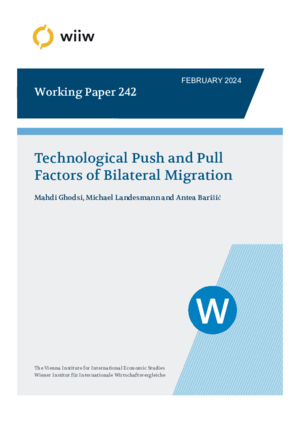Technological Push and Pull Factors of Bilateral Migration
Antea Barišić, Mahdi Ghodsi and Michael Landesmann
wiiw Working Paper No. 242, February 2024
34 pages including 4 Tables and 1 Figure
This paper explores the complex interplay between technology adoption, specifically robotisation and digitalisation, and international migration within the EU and other advanced economies, including Australia, the UK, Japan, Norway and the US, over the period 2001-2019. Utilising a gravity model approach grounded in neoclassical migration theory, the study analyses how technological advancements influence migration flows. It examines two key technological variables: the extent of digitalisation, represented by ICT capital per person employed, and the adoption of industrial robots, measured by the stock of robots per thousand workers. The research uniquely integrates these technological factors into migration analysis, considering both push and pull effects. Additionally, it accounts for various other migration determinants such as macroeconomic conditions, demography and policy factors. The findings reveal insightful dynamics about the relationships between technological progress, labour market conditions and migration patterns, contributing significantly to the current literature and informing future migration policies and the impact of technology adoption.
Keywords: Robot adoption, digitalisation, novel innovation, migrant workers
JEL classification: O33, F22, D24
Countries covered: non specific
Research Areas: Labour, Migration and Income Distribution
